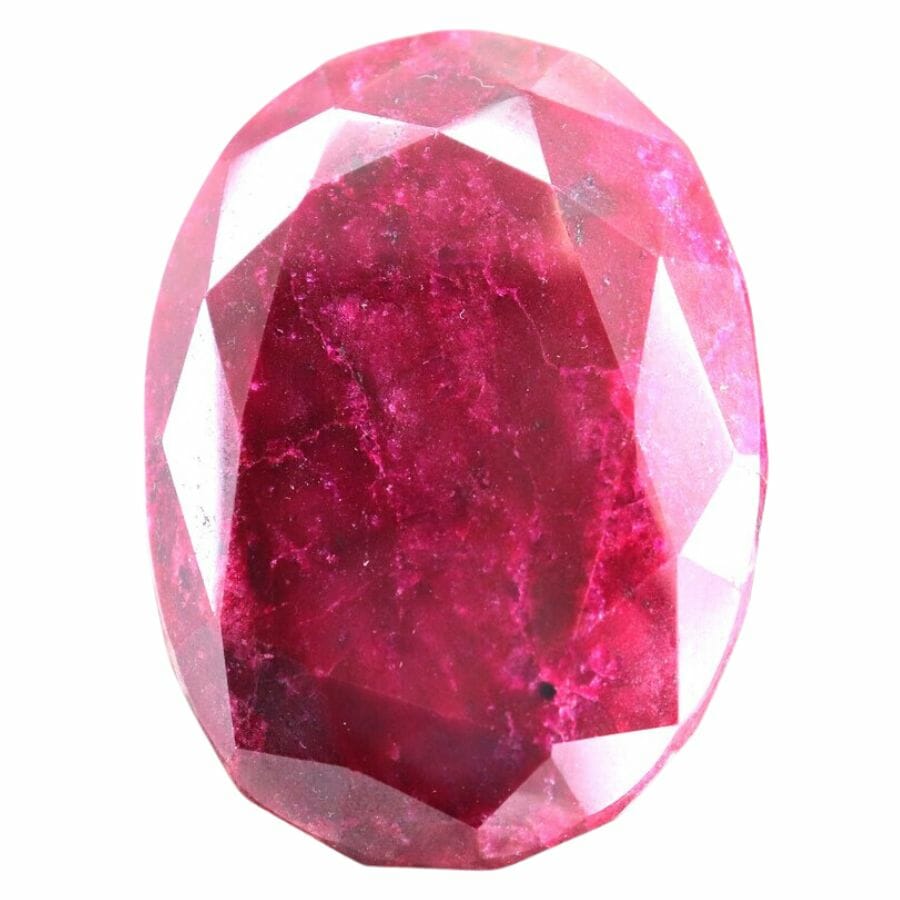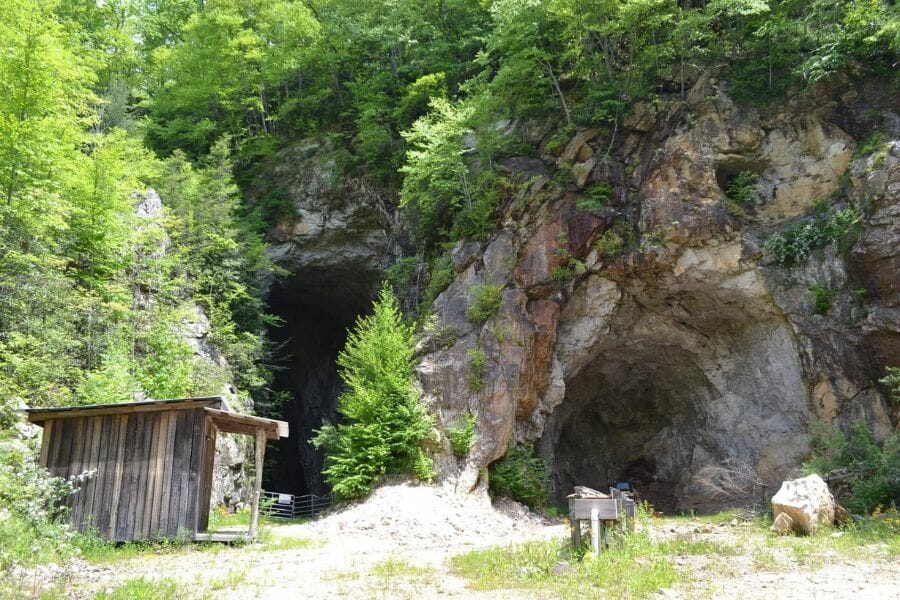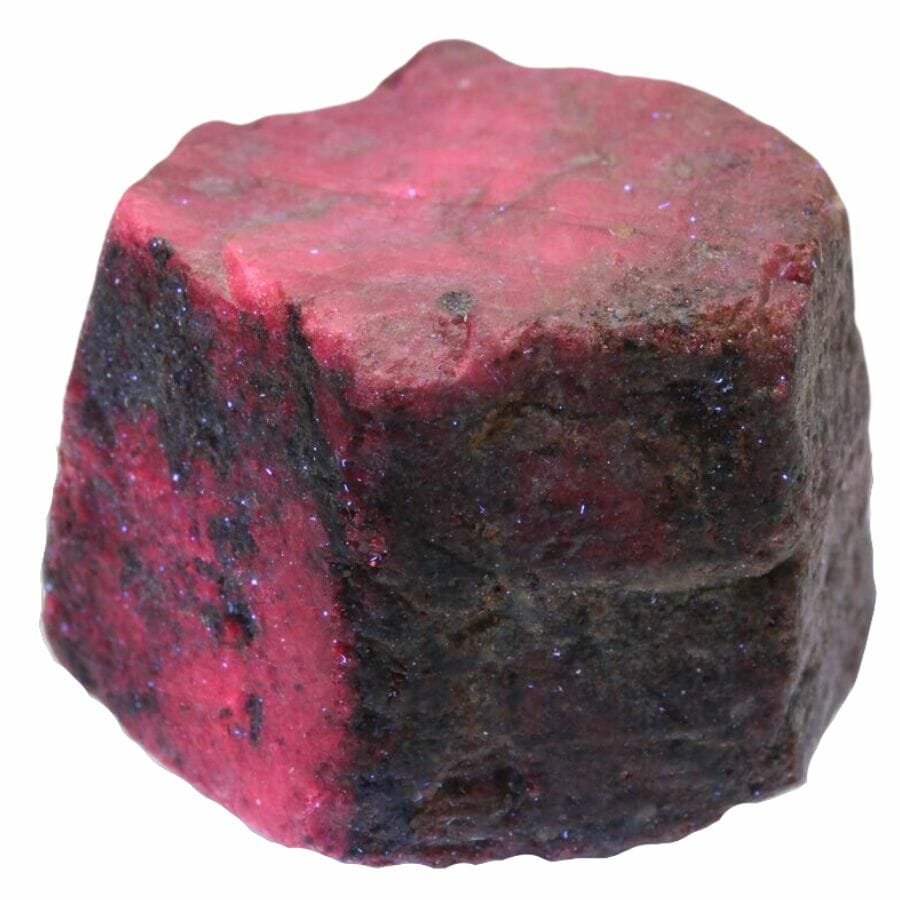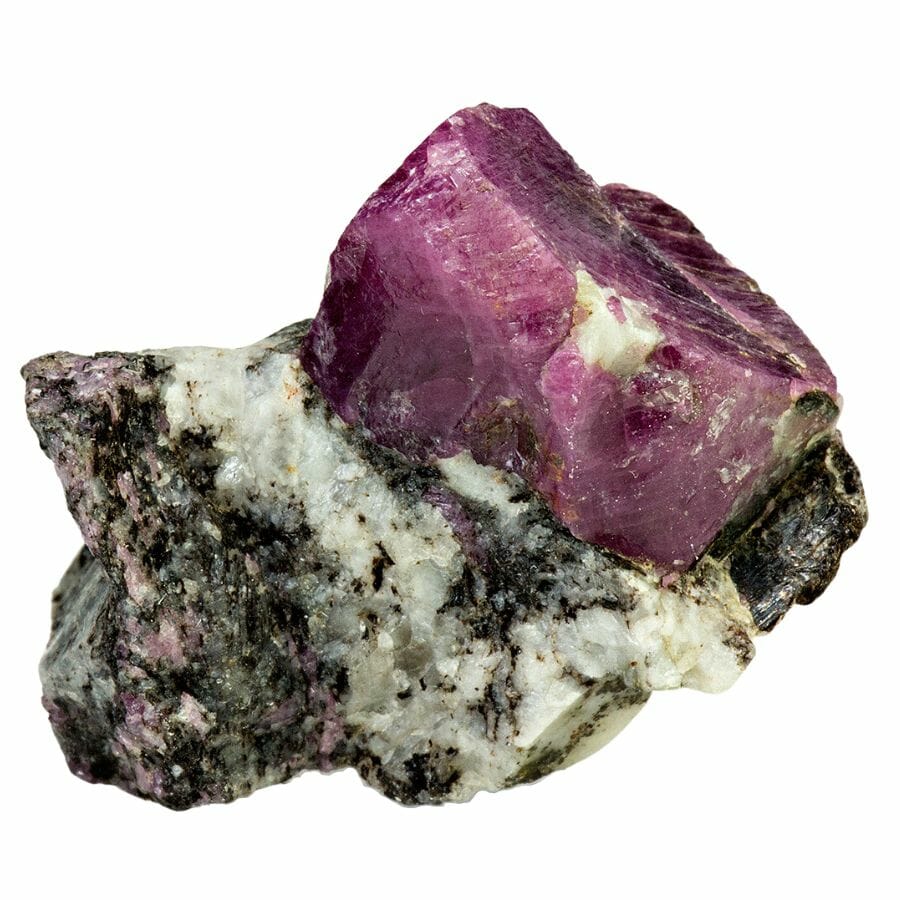Ruby is a gem that has made its mark in history, culture, and fashion. It can be found in countries all over the world, like Thailand, Myanmar, Mozambique, Sri Lanka, and the United States.
Now, if you’re wondering how to identify ruby after finding one, you’ll need to learn its unique traits and how to examine them. This gemstone stands out with its brilliant red hue, but there’s more to it than meets the eye.
So, next time you’re on an adventure, keep these pointers in mind and you might just spot a genuine ruby! Armed with this knowledge, you’re well on your way to uncovering these precious gems.
What ruby is
Ruby is a type of mineral called corundum, and when corundum turns red, we get to call it ruby! It gets its bold color from chromium, a mineral element.
The process of how ruby is formed is quite cool. Deep inside the Earth, under heat and pressure, ruby crystals grow. Over time, they push their way to the surface, and that’s where we find them.
Rubies have another intriguing characteristic: they can glow under certain lights because they contain chromium. In the United States, people often find rubies in places like North Carolina, South Carolina, and Montana.
The different types of ruby
From deep crimson shades to lighter pink hues, each type of ruby has its own story. These differences come from where they’re found and how they’ve formed.
Burmese Ruby

Burmese ruby stands out in the world of gemstones. Hailing from Myanmar, previously known as Burma, this ruby is celebrated for its vivid red color. This unique shade is often called “pigeon’s blood red” because of its intense and bright hue.
While there are many places around the globe to find rubies, the Burmese ruby is in a league of its own due to this distinct color. Many gem enthusiasts and collectors seek it out, making it a prized possession.
Thai Ruby

Originating from Thailand, this type of ruby often showcases a darker, brownish-red hue. This deeper color sets it apart from its counterparts found in other regions.
While many rubies dazzle with bright reds, the Thai ruby offers a unique warmth and richness with its distinct shade. Gem lovers appreciate this variation because it provides a more earthy look.
So, when looking at a collection of rubies, the Thai ruby’s standout color can easily catch one’s eye, reminding everyone of Thailand’s contribution to the world of precious stones.
Ceylon Ruby

Ceylon ruby comes from the beautiful island of Sri Lanka and has its own signature shades. Unlike some rubies that are very dark or intensely red, Ceylon rubies can vary from a soft, light red to a more vibrant medium red.
This range of colors adds a diverse flair to any gem collection. When someone sees a ruby that sparkles with a softer, sun-kissed glow, there’s a good chance it’s a Ceylon ruby.
African Ruby

African ruby brings a tapestry of colors and qualities to the gemstone world. Sourced from diverse landscapes like Mozambique, Tanzania, and Madagascar, each region adds its own touch to this precious stone.
One of the exciting things about African rubies is their wide-ranging appearance. Some might glow with a deep, rich red, while others have a lighter, more radiant hue.
Because of this variety, African rubies offer a delightful surprise element; you’re never quite sure the shade or quality you’ll stumble upon.
Afghan Ruby

Afghan ruby is a captivating gem that originates from the rugged terrains of Afghanistan. Known for its good color, this ruby often boasts a beautiful hue that gem enthusiasts appreciate.
However, what sets Afghan rubies apart is that they often have little marks or inclusions inside them. These inclusions are like nature’s own fingerprints, giving each ruby its own unique character.
While some rubies from other places might be clearer, the inclusions in Afghan rubies tell a different story. So, when you come across a ruby with a lovely color and nature’s little signatures inside, it could well be an Afghan treasure!
Vietnamese Ruby

Vietnamese ruby has a special trait: it can often match the famous Burmese ruby in its beauty and allure. That’s a big deal in the gem world! Its vibrant hue and brilliance make it a sought-after choice for many.
So, if you spot a ruby that sparkles just as magnificently as a Burmese one, but with its own unique charm, there’s a good chance it’s from Vietnam.
Star Ruby

Star ruby’s name comes from the unique star-like pattern that dances on its surface, which is caused by something called asterism.
This amazing pattern isn’t just a random feature; it’s caused by the reflection of light off tiny, needle-like pieces inside the ruby.
These pieces are from a mineral called rutile. When light hits them just right, a star shines on the ruby’s surface.
While you can find rubies in many parts of the world, star rubies are a rare treat and a true wonder of nature.
Where to find ruby
From east to west, there are spots across the United States that are known for their ruby deposits. Before we dive in, let’s set the stage by highlighting the five best places to find this dazzling gem.
Cowee Valley, North Carolina

Cowee Valley is a gem hunter’s paradise, especially if you’re on the lookout for rubies! Found within the scenic landscapes of Macon County, this valley has become a hotspot where you can find ruby.
Over the years, many enthusiasts have been drawn to its soil, hoping to discover a precious red gem. The types of rubies you can uncover here range from deep crimson to lighter pink shades.
Some might even have a shimmering star pattern on their surface due to special inclusions inside.
With multiple mines and dig-your-own spots, Cowee Valley offers everyone from beginners to seasoned experts a chance to uncover a piece of nature’s brilliance.
Wind River Range, Wyoming

The Wind River Range is a striking stretch of mountains known not just for its breathtaking views but also for its mineral treasures beneath the ground. For those passionate about ruby hunting, this area is a fantastic spot to explore.
The region’s unique geology has allowed for the formation of rubies that vary from pinkish tones to more robust reds. The thrill of finding a gem in such a beautiful natural setting makes the experience even more special.
With every scoop of earth, there’s a chance of unveiling a gleaming ruby. So, if you’re eager for an adventure filled with scenic beauty and the excitement of discovery, Wind River Range is a destination you won’t want to miss.
Gem Mountain Gemstone Mine, North Carolina

Gem Mountain Gemstone Mine is a must-visit spot for those with a keen eye and a love for sparkly finds. This location is famous for its abundance of precious gems, with rubies being one of the top attractions.
When you dig into the rich soils of this mine, you can uncover rubies that range from pinkish hues to deeper reds. Many enthusiasts and families flock to this spot, hoping to find their own shimmering keepsake.
Rock Creek, Montana

Tucked within Montana’s vast landscapes, Rock Creek is the answer to where to find ruby in real life. When you explore Rock Creek, you’ll discover rubies that have a range of colors, from radiant reds to lovely pinks.
Each stone carries the legacy of the land and time itself, making every find a special connection to Earth’s history. The environment is not just rich in rubies but also offers breathtaking views that add to the adventure.
With its combination of natural beauty and the thrill of discovery, Rock Creek is a top destination for anyone hoping to uncover nature’s buried treasures.
Missouri River, Montana

Missouri River is more than just flowing waters; it’s a gem hunter’s delight. Amid the vast beauty of Big Sky Country, this river has pockets where you can uncover dazzling rubies.
The rubies found here can vary from vibrant reds to subtle pinks, each telling a tale of the land from which they emerged.
Exploring the banks and nearby areas, adventurers have the chance to discover these radiant gems, making every search an exciting journey.
The serene landscapes and clear waters of the Missouri River add to the overall experience. For those passionate about nature’s treasures, this Montana river offers a fantastic expedition.
How to find ruby
While rubies are tucked away in various corners of the Earth, there are specific methods to uncover them. From exploring riverbeds to looking for indications of ruby, each approach offers its own thrill.
Stream and riverbed searching
Searching streams and river beds can be a fun and rewarding way to find rubies. Over time, water currents can carry these gems from their original source and deposit them downstream.
Start by choosing a spot where the water slows down, like the inside curve of a bend. These areas often collect heavier materials, including gemstones.
Use a sieve or a gold panning dish to scoop up gravel and sand. Gently swish it around in the water, letting the lighter materials flow out. Keep an eye out for shiny red stones among the heavier materials left behind.
Tailings and dumps
If you’re curious about how to find a ruby, tailings and dumps are a great place to start. These are piles of discarded materials from mines. Over the years, miners have left behind valuable gems in these heaps.
To search in tailings and dumps, you’ll need a sturdy shovel and a sifting screen. Begin by shoveling some material onto your screen. Shake it gently to let smaller particles fall through, leaving potential gems on top.
Wearing gloves, pick through the remains on your screen. Keep an eye out for that distinct red gleam! Remember, patience is key; the search is part of the fun.
Look for corundum indicators
Finding ruby becomes a bit easier when you know they’re a type of mineral called corundum. By looking for corundum indicators, you’re on the right track to uncovering these gems.
Corundum often forms in metamorphic rocks like schist and marble or igneous rocks like basalt. When exploring, keep an eye out for these rock types.
Also, look for signs of wear on rocks, as corundum is harder than most minerals and can leave scratch marks.
If you spot areas with shiny, metallic-looking minerals called mica, that’s another good sign! Corundum sometimes hangs out near mica.
By paying attention to these clues, you can hone in on areas more likely to hold ruby, making your gem hunting more fruitful and exciting!
Equipment matters
If you’re on the hunt for rubies, having the right equipment can make all the difference. Start with a sturdy shovel to dig into the earth, reaching areas where gems might be hidden.
Next, a sieve or mesh screen is super helpful. Scoop up some dirt and rocks, give it a good shake, and watch as smaller materials fall through, leaving potential gemstones behind.
A small pick or chisel can help extract rubies from harder rock formations. And don’t forget a magnifying glass! With it, you can take a closer look at your finds to check for that signature ruby sparkle.
Equipped with these tools, your search for rubies will be both fun and efficient!
How to identify ruby once you find it
Finding a gemstone is only half the adventure; knowing how to identify it is the other half! Rubies have specific traits that make them stand out from other stones. Recognizing these characteristics can help confirm you’ve found a true ruby.
What ruby looks like on the outside
When you’re on the hunt for gemstones, knowing what to look for is essential. The outer appearance of a ruby has distinct features that set it apart from other stones.
Color

When you think about how to find ruby, one of the first clues is its distinct color. Rubies are known for their captivating red shades. The variety in their hues can be quite broad, spanning from a soft, delicate pink to a fiery, intense crimson.
This beautiful range of reds isn’t just a random occurrence; it’s due to chromium, a special element present in the mineral. Chromium not only gives rubies their iconic color but also contributes to their glow and allure.
So, when you’re out searching and stumble upon a stone that sparkles with shades of pink to deep red, there’s a good chance you’ve found a genuine ruby!
Hexagonal crystals

When considering what ruby looks like on the outside, one feature stands out prominently: its shape. These striking gems, in their natural and uncut form, often show off a hexagonal or six-sided shape.
This unique form isn’t just by chance. It’s a defining characteristic of the mineral corundum, the family to which both rubies and sapphires belong.
So, if you stumble upon a crystal that boasts a hexagonal structure, you might be onto something special!
This shape can be a great clue in identifying a genuine ruby from other similar-looking stones.
Fluorescence

One of the coolest features of rough ruby crystals is their ability to glow with a strong red fluorescence when exposed to ultraviolet light.
Picture this: in a dim setting, shining a UV light on a ruby makes it come alive, glowing with a radiant red light. This isn’t just a random feature; it’s because of the chromium inside the ruby.
Chromium does two awesome things for rubies: it gives them their signature red color and causes them to fluoresce so vividly.
This glowing characteristic can be a handy tool when trying to identify a genuine ruby, making it even more of a standout gem in the world of minerals.
What ruby looks like on the inside
While the outer beauty of a ruby can be mesmerizing, its inner characteristics are equally fascinating. Peering inside this gem reveals a world of intricate details and clues about its history and formation.
Inclusions

Inclusions are like tiny secrets held inside a gemstone, and rubies have their own tales to tell with them. These inclusions are little imperfections or materials trapped inside the ruby while it was forming.
They can look like clouds, bubbles, or even tiny crystals of other minerals. In the world of gemstones, inclusions can sometimes be seen as flaws. But, they also give each ruby its unique character, making every gem different from the next.
For many, these inclusions prove that the gem is natural and not man-made. So, when you spot inclusions in a ruby, remember you’re seeing a bit of its journey from deep within the Earth.
Fractures and fissures

Fractures and fissures inside a ruby tell an interesting story of its journey deep within the Earth.
These are breaks or cracks that can form due to various reasons, like changes in temperature, pressure, or even when the stone faced some external force during its formation.
They can appear as thin lines or patterns, creating unique internal landscapes within the gem. Some fissures can even trap tiny minerals, adding more character to the ruby’s inner world.
While fractures might seem like imperfections, they’re a natural part of many gemstones and give each ruby its own unique identity.
Silk

When we talk about what ruby looks like on the inside, one captivating feature is its “silk.” This silk refers to fine, needle-like inclusions, often made of rutile.
These delicate inclusions weave a network within the gem, crisscrossing and intertwining in various patterns. Sometimes, these tiny needles can be so dense that they endow the ruby with a mesmerizing silky sheen.
The presence of silk doesn’t just add beauty but can also be an indication of the gem’s origin and formation conditions.


